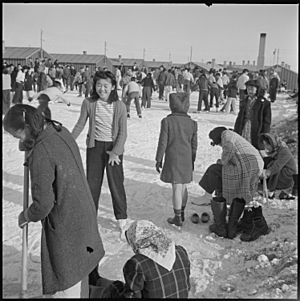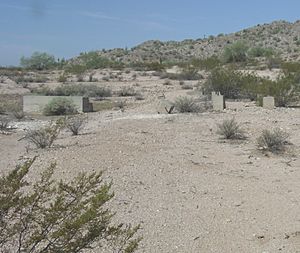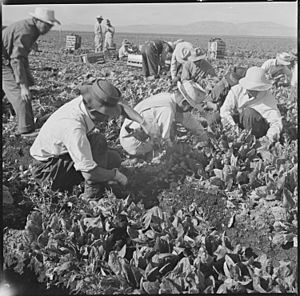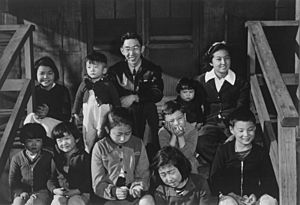List of Japanese-American internment camps facts for kids
During World War II, the United States had different types of camps for Japanese people and Japanese-Americans. These camps were set up after the attack on Pearl Harbor, when the government worried about national security. Many innocent people were forced to leave their homes and live in these camps.
There were three main kinds of camps:
- Civilian Assembly Centers were temporary places. People were sent here first after being removed from their communities.
- Relocation Centers were more permanent camps. Most people from the assembly centers were moved to these. They are often called internment camps or incarceration centers today.
- Detention Camps held people who the government thought might cause trouble or were of special interest.
Contents
Temporary Assembly Centers
These were the first stops for many Japanese Americans. They were often set up quickly in places like fairgrounds or racetracks. People lived in temporary housing, sometimes even in horse stables.
- Arcadia, California (Santa Anita Racetrack, stables)
- Fresno, California (Fresno Fairgrounds, racetrack, stables)
- Marysville / Arboga, California (migrant workers' camp)
- Mayer, Arizona (Civilian Conservation Corps camp)
- Merced, California (county fairgrounds)
- Owens Valley, California
- Parker Dam, Arizona
- Pinedale, California (Pinedale Assembly Center, warehouses)
- Pomona, California (Los Angeles County Fairgrounds, racetrack, stables)
- Portland, Oregon (Pacific International Livestock Exposition, including 3,800 housed in the main pavilion building)
- Puyallup, Washington (fairgrounds racetrack stables, also known as "Camp Harmony")
- Sacramento, California Camp Kohler (Site of Present-Day Walerga Park) (migrant workers' camp)
- Salinas, California (fairgrounds, racetrack, stables)
- San Bruno, California (Tanforan racetrack, stables)
- Stockton, California (San Joaquin County Fairgrounds, racetrack, stables)
- Tulare, California (fairgrounds, racetrack, stables)
- Turlock, California (Stanislaus County Fairgrounds)
- Woodland, California
Permanent Relocation Centers
These were the larger, more long-term camps where Japanese Americans were forced to live for most of World War II. They were built in remote areas. Life in these camps was very difficult, with harsh conditions and limited freedom.
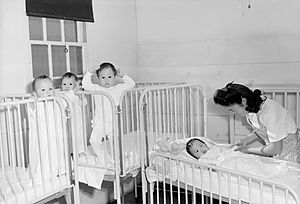
- Gila River War Relocation Center, Arizona
- Granada War Relocation Center, Colorado (also called "Amache")
- Heart Mountain War Relocation Center, Wyoming
- Jerome War Relocation Center, Arkansas
- Manzanar War Relocation Center, California
- Minidoka War Relocation Center, Idaho
- Poston War Relocation Center, Arizona
- Rohwer War Relocation Center, Arkansas
- Topaz War Relocation Center, Utah
- Tule Lake War Relocation Center, California
Justice Department Detention Camps
These camps were run by the U.S. Department of Justice. They held people who the government thought were a risk. This included not only Japanese Americans but also some German Americans and Italian Americans.
- Crystal City, Texas
- Fort Lincoln Internment Camp
- Fort Missoula, Montana
- Fort Stanton, New Mexico
- Kenedy, Texas
- Kooskia, Idaho
- Santa Fe, New Mexico
- Seagoville, Texas
- Forest Park, Georgia
Citizen Isolation Centers
These special centers were for people who were considered "problem inmates" within the larger relocation camps. They were sent here if they caused trouble or were seen as disobedient.
- Leupp, Arizona
- Moab, Utah (also called Dalton Wells)
- Fort Stanton, New Mexico (also called Old Raton Ranch)
Federal Prisons for Detainees
Some people were sent to federal prisons. This usually happened if they were found guilty of crimes, such as refusing to join the military when called upon (draft resistance).
U.S. Army Facilities
The U.S. Army also ran some camps. Like the Justice Department camps, these often held German and Italian detainees in addition to Japanese Americans.
- Fort McDowell/Angel Island, California
- Camp Blanding, Florida
- Camp Forrest, Tennessee
- Camp Livingston, Louisiana
- Camp Lordsburg, New Mexico
- Camp McCoy, Wisconsin
- Florence, Arizona
- Fort Bliss, New Mexico and Texas
- Fort Howard, Maryland
- Fort Lewis, Washington
- Fort Meade, Maryland
- Fort Richardson, Alaska
- Fort Sam Houston, Texas
- Fort Sill, Oklahoma
- Griffith Park, California
- Honouliuli Internment Camp, Hawaiʻi
- Sand Island, Hawaiʻi
- Stringtown, Oklahoma
Immigration and Naturalization Service Facilities
These places were run by the Immigration and Naturalization Service (INS). They were used to hold about 5,500 men who were arrested right after the attack on Pearl Harbor. They also held thousands of German and Italian detainees. These facilities often served as places where people were processed before being sent to Justice Department or Army camps.
- East Boston Immigration Station
- Ellis Island
- Cincinnati, Ohio
- San Pedro, Los Angeles
- Seattle, Washington
- Sharp Park, California
- Tuna Canyon, Los Angeles
See also


